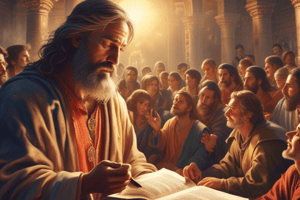Podcast
Questions and Answers
Questions are hidden until you start the quiz
Study Notes
Mark's Gospel: Overview and Structure
- Mark's gospel is considered to be the first of the gospels to be written, with a dating range of 67-73 AD.
- The exact date of Mark's gospel is uncertain due to lack of definitive external or internal evidence.
- The temple destruction in Mark 13:2 is a key piece of information for dating the gospel, with some scholars believing it reflects a past event (early 70s) and others thinking it's a prophecy (just before 70 AD).
Characteristics of Mark's Gospel
- Mark's gospel is shorter than Matthew and Luke's gospels, with only 16 chapters.
- Mark's writing style is characterized by the frequent use of "immediately," giving a sense of urgency and pace.
- Some scholars suggest that Mark's style may indicate an eyewitness account, with "immediately" reflecting Peter's enthusiastic remembrances.
Mark's Theology
- Mark's gospel has a narrative theology, with the narrative conveying theological themes.
- Mark's gospel is often analyzed using narrative criticism, which examines how the narrative communicates theology.
- Mark's account is often more detailed than Matthew and Luke's, providing a richer understanding of the narrative.
Structure of Mark's Gospel
- Mark's gospel can be divided into four sections of four chapters each, with each section exploring different themes.
- The first section (chapters 1-4) is an introductory section, introducing key features of Jesus's ministry.
- The second section (chapters 5-8) explores discipleship, with key encounters between Jesus and his disciples.
- The third section (chapters 9-12) explores the Journey to Jerusalem, with a focus on Jesus's teachings and conflicts.
- The fourth section (chapters 13-16) explores the Passion Narrative, with a focus on Jesus's death and resurrection.
Key Groups in Mark's Gospel
- Three groups of characters are prominent in Mark's gospel: the scribes and Pharisees, the crowd, and the disciples.
- The scribes and Pharisees are consistently negative, responding to Jesus with criticism and rejection.
- The crowd is consistently amazed, but ultimately fails to understand Jesus's teachings.
- The disciples are characterized by their lack of understanding, despite Jesus's explanations and teachings.
Themes in Mark's Gospel
- The gospel reflects on the nature of response to Jesus, with the three groups of characters serving as examples of different responses.
- The question of "how will you respond?" is a central theme of the gospel.### Mark's Gospel and its Ending
- Mark's gospel is considered to be highly important, but the last two pages of Mark's gospel seem to be missing, leading to the inclusion of additional endings (shorter and longer endings) in some manuscripts.
- The additional endings do not match the original style and language of Mark's gospel, and are not found in the most reliable manuscripts.
- The options for the ending of Mark's gospel are: either it genuinely ends at 16:8, or it doesn't, and the ending is lost.
The Messianic Secret
- The Messianic Secret is a theme in Mark's gospel where Jesus frequently tells people not to mention who he is, even after performing remarkable miracles.
- This theme is intriguing, as it suggests that Jesus' Messiahship should be kept secret in some way.
- The Messianic Secret is contrasting with the command to "go tell" the good news at the end of Mark's gospel.
The Beginning and End of Mark's Gospel
- The beginning of Mark's gospel (Mark 1:1) starts abruptly, without any introduction or attempt to ease the reader into the story.
- The opening verse, "The beginning of the gospel of Jesus Christ, the Son of God," may be more than just an announcement of the start of the gospel; it could be the title of the whole gospel.
- This interpretation implies that the gospel is not just a story, but a beginning, and there is a continuation and a further ending to be lived out in the lives of the readers.
The Structure of Mark's Gospel
- Mark's gospel can be divided into four sections:
- Introduction to Jesus (chapters 1-3)
- Discipleship (chapters 4-8)
- The shadow of the cross (chapters 9-10)
- Jesus' death and resurrection (chapters 11-16)
- The structure of Mark's gospel is carefully designed to lead the reader to respond to Jesus.
Discipleship
- The word "disciple" means "a learner" (from the Greek word "mathetes" and Latin "discipulus").
- The disciple is someone who learns from Jesus and becomes a follower.
- Chapters 4-8 of Mark's gospel reflect on what it means to be a disciple and how to learn from Jesus.
- The discipleship section is followed by the shadow of the cross, where Jesus' focus turns to the cross, and the disciples are expected to follow him to the crucifixion.
- The climax of Mark's gospel is Jesus' death and resurrection, where the reader understands who Jesus is because of his death and resurrection.
Studying That Suits You
Use AI to generate personalized quizzes and flashcards to suit your learning preferences.




